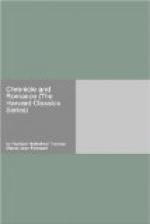and well dressed, and out of this is the coarsest of
the bran (usually called gurgeons or pollard) taken.
The ravelled is a kind of cheat bread also, but it
retaineth more of the gross, and less of the pure
substance of the wheat; and this, being more slightly
wrought up, is used in the halls of the nobility and
gentry only, whereas the other either is or should
be baked in cities and good towns of an appointed
size (according to such price as the corn doth bear),
and by a statute provided by King John in that behalf.[4]
The ravelled cheat therefore is generally so made
that out of one bushel of meal, after two and twenty
pounds of bran be sifted and taken from it (whereunto
they add the gurgeons that rise from the manchet),
they make thirty cast, every loaf weighing eighteen
ounces into the oven, and sixteen ounces out; and,
beside this, they so handle the matter that to every
bushel of meal they add only two and twenty, or three
and twenty, pound of water, washing also (in some
houses) their corn before it go to the mill, whereby
their manchet bread is more excellent in colour, and
pleasing to the eye, than otherwise it would be.
The next sort is named brown bread, of the colour
of which we have two sorts one baked up as it cometh
from the mill, so that neither the bran nor the flour
are any whit diminished; this, Celsus called autopirus
panis, lib. 2, and putteth it in the second place
of nourishment. The other hath little or no flour
left therein at all, howbeit he calleth it Panem
Cibarium, and it is not only the worst and weakest
of all the other sorts, but also appointed in old
time for servants, slaves, and the inferior kind of
people to feed upon. Hereunto likewise, because
it is dry and brickle in the working (for it will
hardly be made up handsomely into loaves), some add
a portion of rye meal in our time, whereby the rough
dryness or dry roughness thereof is somewhat qualified,
and then it is named miscelin, that is, bread
made of mingled corn, albeit that divers do sow or
mingle wheat and rye of set purpose at the mill, or
before it come there, and sell the same at the markets
under the aforesaid name.
[4] The size of
bread is very ill kept or not at all looked
unto in the country
towns or markets.—H.
In champaign countries much rye and barley bread is eaten, but especially where wheat is scant and geson. As for the difference that it is between the summer and winter wheat, most husbandmen know it not, sith they are neither acquainted with summer wheat nor winter barley; yet here and there I find of both sorts, specially in the north and about Kendal, where they call it March wheat, and also of summer rye, but in so small quantities as that I dare not pronounce them to be greatly common among us.




